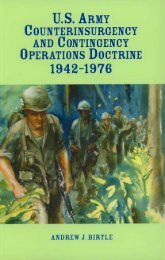C. Wiebes - Intelligence en de oorlog in Bosnië 1992-1995. De rol van de inlichtingen- en veiligheidsdiensten - Engels
C. Wiebes - Intelligence en de oorlog in Bosnië 1992-1995. De rol van de inlichtingen- en veiligheidsdiensten - Engels
C. Wiebes - Intelligence en de oorlog in Bosnië 1992-1995. De rol van de inlichtingen- en veiligheidsdiensten - Engels
- No tags were found...
You also want an ePaper? Increase the reach of your titles
YUMPU automatically turns print PDFs into web optimized ePapers that Google loves.
110disposal. Their <strong>in</strong>tellig<strong>en</strong>ce officer, Wieffer, had two daily Situation Reports as <strong>in</strong>put: one from SNEand one from BHC. On the basis of these, the <strong>in</strong>tellig<strong>en</strong>ce officer held a brief<strong>in</strong>g for the battalion staffand the comman<strong>de</strong>rs every day. With<strong>in</strong> a company, the comman<strong>de</strong>rs kept their staff and ranks<strong>in</strong>formed via a weekly brief<strong>in</strong>g on <strong>de</strong>velopm<strong>en</strong>ts <strong>in</strong> Srebr<strong>en</strong>ica. 504The flow of <strong>in</strong>formation that Wieffer received from below once he was <strong>in</strong> Srebr<strong>en</strong>ica camefrom pat<strong>rol</strong>s and OPs. They were reported on paper, via communications equipm<strong>en</strong>t, or both. Thisdata was th<strong>en</strong> translated <strong>in</strong>to a flow of <strong>in</strong>formation that was s<strong>en</strong>t to the higher echelon. In his case, thiswas SNE <strong>in</strong> Tuzla. The problem with this flow of <strong>in</strong>formation was that on a number of occasionsWieffer found that wh<strong>en</strong> he wanted to have more <strong>in</strong>formation on a specific subject, this <strong>in</strong>formationwas not forthcom<strong>in</strong>g. Dutchbat knew, for example, that a reconnaissance flight had be<strong>en</strong> carried out byNATO, because they saw the aircraft overhead. They th<strong>en</strong> issued an ‘overflight report’. However, Im<strong>in</strong>tfrom reconnaissance flights was not han<strong>de</strong>d over to Dutchbat by UNPROFOR or NATO.What were Dutchbat’s <strong>in</strong>tellig<strong>en</strong>ce needs?The question th<strong>en</strong> is what sort of <strong>in</strong>formation did Dutchbat want. There was a need for <strong>in</strong>tellig<strong>en</strong>ce onoverall <strong>de</strong>velopm<strong>en</strong>ts <strong>in</strong> Bosnia <strong>in</strong> or<strong>de</strong>r to build up an accurate picture. If the fight<strong>in</strong>g flared upelsewhere <strong>in</strong> Bosnia, this could have consequ<strong>en</strong>ces for an <strong>in</strong>t<strong>en</strong>sification of the activities of the warr<strong>in</strong>gfactions themselves. Of more direct <strong>in</strong>terest was knowledge of the ev<strong>en</strong>ts <strong>in</strong> the immediatesurround<strong>in</strong>gs of the <strong>en</strong>clave, for example, with<strong>in</strong> a radius of 5 to 10 kilometres. 505 Sector North East(SNE) and Bosnia-Hercegov<strong>in</strong>a Command (BHC) did not supply this <strong>in</strong>formation, and the sporadicreconnaissance platoon pat<strong>rol</strong>s outsi<strong>de</strong> the <strong>en</strong>clave dur<strong>in</strong>g Dutchbat I and II could only provi<strong>de</strong>fragm<strong>en</strong>ts of the <strong>in</strong>formation requirem<strong>en</strong>t. The UNMOs were also barely able to fill this gap. Theirfreedom of movem<strong>en</strong>t was limited and they had no access to Bosnian-Serb areas. 506 Dutchbat pat<strong>rol</strong>ssometimes supplied <strong>in</strong>formation on activities around the <strong>de</strong>marcation l<strong>in</strong>e, but it was not possible forthem to pat<strong>rol</strong> <strong>in</strong> secret. The <strong>de</strong>parture of a pat<strong>rol</strong> was oft<strong>en</strong> reported to the ABiH or VRScomman<strong>de</strong>rs by <strong>in</strong>formants at the compound gate or <strong>in</strong> the vic<strong>in</strong>ity of the OPs, so that measures couldbe tak<strong>en</strong> to conceal military activities and weapons from the pat<strong>rol</strong>.Did Dutchbat receive no <strong>in</strong>tellig<strong>en</strong>ce at all, th<strong>en</strong>?All of the problems listed above could lead to the conclusion that Dutchbat was completely<strong>in</strong>tellig<strong>en</strong>ce-bl<strong>in</strong>d, but that was most certa<strong>in</strong>ly not the case. As a result of its frequ<strong>en</strong>t contacts with thewarr<strong>in</strong>g factions and with the refugees <strong>in</strong> the <strong>en</strong>clave, Dutchbat I had a large amount of <strong>in</strong>formation atits disposal, which was also analysed. The battalion comman<strong>de</strong>r usually ad<strong>de</strong>d a Comman<strong>de</strong>r’sAssessm<strong>en</strong>t to the Sitreps, <strong>in</strong> which he gave an evaluation of <strong>de</strong>velopm<strong>en</strong>ts <strong>in</strong> the <strong>en</strong>clave, theirpossible relationship with external ev<strong>en</strong>ts and a short-term outlook. This happ<strong>en</strong>ed to a lesser ext<strong>en</strong>twith Dutchbat II, partly due to the <strong>de</strong>teriorat<strong>in</strong>g relationship with the ABiH. Un<strong>de</strong>r Dutchbat III, thistr<strong>en</strong>d cont<strong>in</strong>ued. 507 An important source of <strong>in</strong>tellig<strong>en</strong>ce disappeared because of the sharp <strong>de</strong>cl<strong>in</strong>e <strong>in</strong>contact with the ABiH and VRS.All <strong>in</strong> all, the <strong>in</strong>tellig<strong>en</strong>ce picture rema<strong>in</strong>ed limited for Dutchbat III. Information on military<strong>de</strong>velopm<strong>en</strong>ts <strong>in</strong> the area around the <strong>en</strong>clave was barely available, which fostered the feel<strong>in</strong>g ofisolation that visitors sometimes also noticed. G<strong>en</strong>eral Smith spoke of a ‘siege m<strong>en</strong>tality’ on the part ofDutchbat III, an assessm<strong>en</strong>t shared by the Operations Officer at SNE, the British Lieut<strong>en</strong>ant Colonel508Le Hardy.504 Interview with E. Wieffer, 07/05/01.505 Interview with E. Wieffer, 18/06/99.506 Interview with E. Wieffer, 18/06/99.507 Dutchbat <strong>in</strong> vre<strong>de</strong>snaam,pp. 108 and 156.508 Interview s with R. Smith, 12/01/00 and C.A. Le Hardy, 08/10/97.





